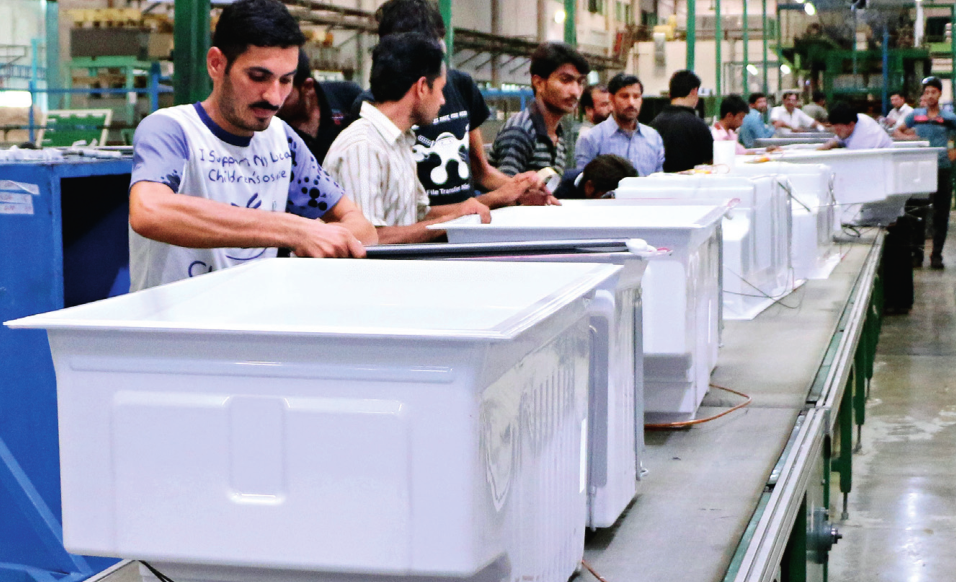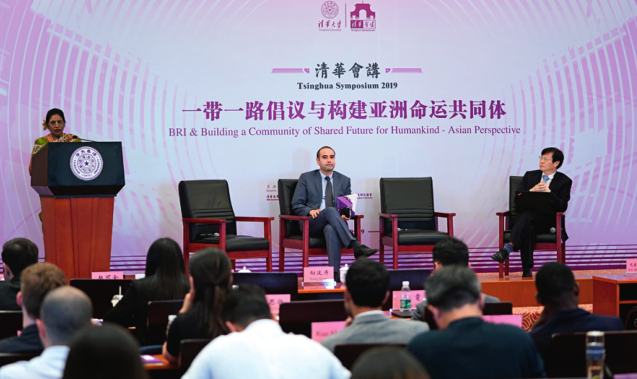
Pakistani workers work on the assembly line in the refrigerator workshop in Haier-Ruba Economic Zone.
WITH the trend of multi-polarization, economic globalization, cultural diversity, and wide IT application, the uncertainties in the international landscape have been increasing and the global challenges we face have never been more serious. In this scenario, there is still hope for the world to continue its development which depends on a prosperous, stable, and sustainable Asia.
According to “The Least Developed Countries Report 2018” released by the United Nations Conference on Trade and Development (UNCTAD), in 1971 there were merely 24 countries ranked “the least developed” in the world; while in 2018 the number soared up to 47, among which nine were in Asia. Over the past 40 years, the Chinese government has successfully lifted more than 740 million people out of poverty, a remarkable contribution to the world’s poverty alleviation efforts. China has summarized its development experience and shared it with the rest of the world.
A Driving Force for the Rise of Asia
Both Asia and the rest of the world have seen and benefited from China’s opening-up. Unlike the Trump administration which always claims “America First,” the Chinese government, on the contrary, never shuns away from other nations’ development needs nor closes its door to the world. In the past decade, China has made a contribution of 30 percent to the growth of global economy. “Made in China” has saved trillions of U.S. dollars for consumers in developed countries, offering a relatively equal “commodity democracy” to low- and middle-income people in developing countries.
“China’s door will not be closed, it will only open wider and wider.” Chinese leaders have declared to take further steps, such as substantially lowering market access threshold and expanding imports, a testimony to the fact that China has been promoting globalization and benefiting all peoples with concrete actions.
Over the past 40 years, particularly after China’s entry into WTO in 2001, Asia has become the area with the fastest economic growth around the world owing to the more open policies and the skyrocketing development of China. One example of this is the establishment of the Asian Infrastructure Investment Bank (AIIB) on December 25, 2015. This is the first time China initiated the creation of an international multilateral financial institute with the idea of inter-connectivity. By the end of 2018, members of AIIB had increased to 93 after being expanded four times. The second largest multilateral institute only next to the World Bank, it again testifies that China is the driving force for the rise of Asia.
On May 15, with the theme “Pooling the Wisdom of Diverse Civilizations for a Beautiful Asia,” the panel session “Sharing Experience on Asian Governance” was held in Beijing as an important part of the “Conference on Dialogue of Asian Civilizations.” Roughly 300 guests from nearly 50 nations held discussions around three sub-topics: “Asian Wisdom to Promote Political Advancement,” “Asian Solutions to Benefit the People,” and “Asian Community with a Shared Future,” sharing the wisdom of Asian governance.
Korn Dabbaransi, former deputy prime minister of Thailand and chairman of the Asia Pacific Exchange & Cooperation Foundation, highly praised the achievements China has made and called for joint efforts in building a prosperous Asia. “The 21st century belongs to Asian countries. Over the past 40 years, many regions in Asia have seen its development promoted to an unprecedented level, and China is the crucial economic booster of that. The world has witnessed China’s achievements in economy.” Korn Dabbaransi is convinced that China will achieve its poverty alleviation goal by 2020. He called on Asian people to be the master of their own destinies and establish a friendship network to achieve inter-connectivity, leading Asia to a more harmonious and diversified future.
Dialogue between Civilizations v.s. Clash of Civilizations
In contrast to the American political scientist Samuel Huntington’s view of the clash of civilizations which identifies cultural conflicts, scholars and experts attending the above panel session held different views on civilizations, showing their respect to the differences and equality of civilizations, encouraging dialogue between civilizations and mutual learning, expressing their wishes to establish a community with a shared future for all mankind.
Srikanth Kondapalli, director of East Asian Studies Center at Jawaharlal Nehru University, quoted the statement of Kiron Skinner, the director of policy planning at the United States State Department in late April 2019 who declared that the U.S. is considering a “clash of civilization with China.” This action has renewed the debate on this issue again given the fact that these two countries are the two largest economies in the world. In today’s world, some regional situations have deteriorated to racial and religious collisions worldwide. The idea of clash of civilizations has obviously increased the conflicts and spurned opportunities to settle disputes in a peaceful way.
According to Srikanth Kondapalli, all these problems should be settled through dialogues, discussions, and establishing a mutual trust mechanism. In this context, China took the lead in advocating for a community with a shared future for mankind, and the United Nations called for dialogues between different civilizations. All countries should heed it and take action.
Yasushi Akashi, former under-secretary-general of the United Nations, recalled that in the past several centuries, Asia has been invaded and inflicted much damage and destruction by imperialism and barbarism of all kinds. We cannot and must not forget these acts of inhumanity, but at the same time, we are encouraged by the fact that tremendous progress has taken place to make our lives more pleasant and convenient, as well as more civilized. Asian countries have become much closer than ever before, and are also striving to solve problems and alleviate disputes. The estrangement among Asian nations has been decreased. It is the common responsibility for all countries in the region to build a prosperous, vibrant, safe, and harmonious Asia.
Professor Swaran Singh at the Jawaharlal Nehru University pointed out, the rapidly rising large societies of China and India can no longer ignore each other, and their better coordination can help them accelerate their progressive initiatives. Both sides understand their challenges and have established several confidence-building conventions and mechanisms that have repeatedly managed their occasional frictions and standoffs, ensuring that their differences will not lead to disputes. Their rise has also opened new avenues of cooperation at various regional and global forums. This is where both China and India often share their analysis and strategies in addressing multifaceted challenges.
As he noted, harmony and diversity have been the defining features of both Chinese and Indian civilizations. This carries enormous value for our contemporary world. Western civilizations put more focus on individual competition and protection of personal wealth. Asian civilizations have instead focused more on family, community, and human duties that need to become an integral part of a shared human future. The Conference on Dialogue of Asian Civilizations can surely bring global focus on the concept of “harmony and diversity” and ensure that it is duly debated and incorporated in global discourse.

The thematic salon "BRI& Building a Community of Shared Future for Humankind - Asian Perspective" is held in Beijing-based Tshinghua University on May 19, 2019.
Oriental Wisdom in Politics
At the Boao Forum for Asia Annual Conference 2018, Chinese President Xi Jinping summarized four reasons for the success of China’s reform and opening-up, namely people’s arduous struggle, the pursuit of a right development path, thinking that keeps up with the times, and opening up to the outside world, each emphasizing the important role of Chinese people. This experience can help other developing countries change their conditions.
Kim Jong-chun, president of the board of directors of the Korea East Asia Peace Research Institute, agreed with President Xi’s outlook on the people. It is the biggest consensus of Asian nations to benefit its own people. Asian people should depend on their own to build a good life and promote self-development. Asia will usher in three “new eras”: in politics, a new era of a harmonious Asia, owing to the DPRK-U.S. peace talks; in economy, a new era of a collaborative Asia, with more economic cooperation; and in the area of people-to-people exchanges, a new era of a diversified Asia, based on the concept of the community of Asian civilizations. Both Asian countries and their peoples will usher in the new trend of history and integrate the three new eras together into “the community of Asian civilizations” to improve their living standard.
The big Asian family encompasses different civilizations, ethnic groups, and religions. To establish an Asian community with a shared future, all Asian nations should respect other civilizations, their development paths and systems based on the realities of their respective development. In this way they can promote dialogues among different civilizations and development models, creating a more prosperous future.